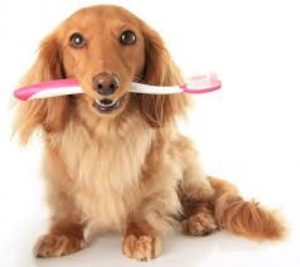 Many people laugh at the idea of brushing their pet’s teeth on a regular basis. However, dental disease is one of the most common and often overlooked problems in dogs and cats . It also is one of the most potent negative factors affecting the long term health of our pets.
Many people laugh at the idea of brushing their pet’s teeth on a regular basis. However, dental disease is one of the most common and often overlooked problems in dogs and cats . It also is one of the most potent negative factors affecting the long term health of our pets.
While cavities represent the most common dental disease of humans, dogs and cats are more frequently bothered by tartar buildup on the teeth. Tartar accumulation leads to irritation of the gums around the base of the teeth, ultimately leading to exposure of the roots.
Potential direct results of this tooth root exposure include gum infections and tooth root abscesses. However, there are many less obvious problems associated with even low grade infections of the gums. Bacteria and bacterial toxins associated with these infections can have negative affects and many body systems including the heart, liver and kidneys. In fact, dental disease has been shown to shorten a pets life by as much as 30%.
Signs that your pet has dental disease are as follows:
Swelling of the gum tissue (known as “gingival tissue”)
Bad breath (known as “halitosis”)
Redness or fluid build-up (edema) of the gums
Variable amounts of plaque (the thin, “sticky” film that builds up on the teeth; composed of bacteria, white-blood cells, food particles, and components of saliva) and tartar or calculus (mineralized plaque on the tooth surface)
Gum surfaces bleed easily on contact (for example, during play, chewing or physical examination)
Loose teeth, missing teeth, and exposure of roots of the teeth
The Factors that contribute to dental disease in pets are many, but over 80% of pets 3-years-old and older have inflammation of the gums (gingivitis). The single most important factor leading to dental disease in pets is that most do not regularly have their teeth brushed. Diet plays a minor role in development of tartar accumulation despite what most people think. Because dry food is not as sticky as canned food, it does not adhere to the teeth as much and thus, does not cause tartar to buildup as rapidly. However, eating dry food does not remove tartar from the teeth.
In pets with otherwise normal mouths, the only way to prevent the risks and the costs associated with dental disease is regular brushing of the teeth at least every other day to scrape off the sticky plaque before it can harden in to tarter. While this may sound daunting, brushing is not as difficult or involved as it sounds. Often good results can be achieved with less than a minutes time commitment every other day. There are also many different products such as gells, water additives, foods and toys that can be used as supplements to brushing to potentiate it’s positive effects.
Once hard tartar forms, however, a professional cleaning is necessary. At Valley View Pet Hospital a full dental cleaning includes complete oral examination; removal of plaque and calculus from the surfaces of the teeth above the gum line (known as “supragingival” surfaces); scaling and root planing (if needed) the surfaces of the teeth below the gum line (known as “subgingival” surfaces); polishing; flushing the tissues below the gum line (known as “subgingival irrigation”) with an antiseptic solution; postcleaning examination and fluoride treatment. If necessary we will take x-rays of your pets mouth to determine if there are any unseen problems such as infected roots. Extraction of retained deciduous teeth (a condition in which both the baby tooth [deciduous tooth] and the permanent or adult tooth are present at the same time) may be necessary. Additionally there may have to be selective extraction of infected or fractured teeth is to improve the health of the mouth. Before you take your pet home we will provide full home-care instructions to hopefully prevent problems in the future.



